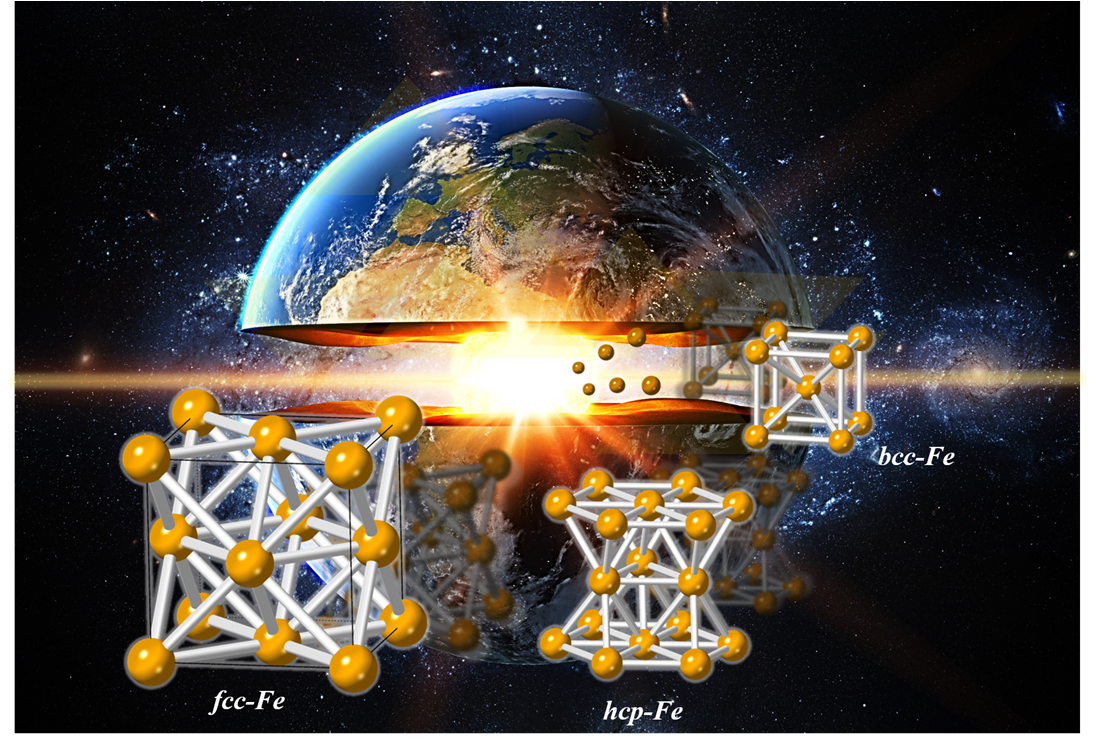
JUNE 11, 2020
An international joint research team led by Professor Yongjae Lee from Yonsei University and HPSTAR, and Dr. Toshimori Sekine and Dr. Wenge Yang of HPSTAR reported how the structure of iron changes when a rapid impact is applied using ultra-fast X-ray measurement technique. Structural changes at the atomic level of iron in such a shock situation provide a fundamental understanding of the formation of planets like Earth or the various utilizations of iron. The results of this study were published in Science Advances, a multidisciplinary journal in all fields of science.
Iron is the most abundant metal in the universe, forming the core of a planet like Earth and forming a magnetic field to protect the Earth's environment. Iron is also abundant in the Earth's crust, and since the iron age, it has been an important material for human civilization to date. A lot of research has been conducted to understand and utilize iron, but understanding of the dynamic change in the impact environment was an unknown area due to difficulties in measurement.
Prof. Lee's team used the newly built 4th generation linear accelerator facility (PAL-XFEL, X-ray free electron laser, small intestine high number) in Pohang, South Korea, to observe the deformation and phase transition process of iron by the impact. To do this, a short picosecond (10-12 second) pulse laser was used to impact the surface of iron, and a shorter femtosecond (10-15 second) pulse X-ray free electron laser was used to probe the atomic changes in iron. Atomistic snapshots were then recorded up to a nanosecond (10-9 seconds) upon the impact. This may be likened to a movie making process by recording thousand films that is shot for a nanosecond featuring iron as the main character.
Iron, as we usually know, has a structure in which the iron atoms are arranged at the center of the cube and at each vertex (bcc phase). However, if the pressure is high enough, the arrangement of iron atoms changes to maximize the density into a hexagonal column pattern (hcp phase), and when the temperature is high enough, the cubic arrangement is again preferred, but unlike the previous case, It turns into a pattern in which iron atoms are arranged in the center of each cube face as well as at each vertex (fcc phase). Interestingly, all of these different characters of iron appear in the film when it is shocked ultrafast.
“The impact on iron using the short pulsed laser is about 1,000 times larger and about 10 million times faster than the impact on hitting iron with a hammer in a forge,” said Dr. Sekine. “Or it can be compared to when a meteorite collides with the Earth's surface.” Dr. Yand added, 'In this extreme condition, the change of iron over such a short period of time, a nanosecond, which is only about 30 centimeters distance even at the speed of light, was even fancy and surpassed our imagination.”

As the shock wave was transmitted to iron, the original bcc phase changed to three separate phases, two phases compressed to different degrees, and the third one in the hcp phase. After this stage, the shock wave releases and interferes one another in such a complex way to generate even expanded bcc and fcc phases before all returns to the original phase. The different phases are distinguished by the different atomic arrangements to have different physical properties, so understanding the transformation processes of iron can provide important clues for the proper understanding and application of a material and its properties.
For this study, Prof. Lee’s team organized an international joint research team from 2017 when the Pohang X-ray free electron laser facility began its operation. Since then, they designed a unique experimental setup of performing ultra-fast shock pump and X-ray probe measurements, and the iron was the first case completed in this work.
Caption: Shocked iro, important element in the universe at XFEL.
近日北京高压科学研究中心的杨文革研究员,Toshimori Sekine研究员与韩国延世大学的Yongjae Lee教授的最新合作使用自由电子激光X衍射测量的方法研究了铁在动态冲击波加载在结构变化。分辨率为皮秒的自由电子激光X射线捕捉到了铁在冲击波压缩过程中的晶体结构变化。在700皮秒内他们准确地观测到了铁从常压下的体心立方到密排六方及面心立方结构的转变以及冲击结束后的结构演变。该结果是首次使用高质量的时间分辨光谱对冲击波压缩下晶体结构直接而完整的诊断。相关结果以“Subnanosecond phase transition dynamics in laser-shocked iron, ” 发表于Science Advances.